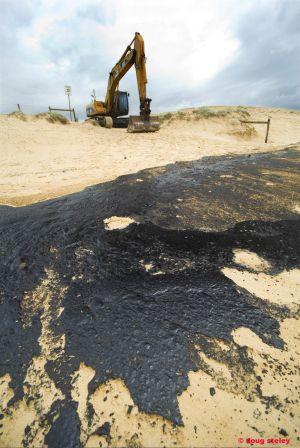
Oil slick on Kawana Beach, Sunshine Coast, Queensland. Photo: Doug Steley, Silver Image Photographics.
By Rachel Borchardt
Cyclone Larry, the Victorian bushfires and the oil spill off Queensland’s Sunshine Coast are just some of the recent disasters that have required local government to swing into action.
A huge amount of planning and preparation work enabled councils to act quickly, but the Local Government Association of Queensland’s Disaster Management Alliance project officer, Michael Dickinson, has warned that new lessons must be learnt following each incident.
“There are always opportunities to continuously improve our preparedness and our ability to respond and help the community recover from major events,” he said.
While coping with disasters is something government has been doing for years, strategy and policy needed to constantly evolve, and planning was essential.
“It should never be underestimated how important planning is to ensuring that your operational response and your community recovery gets off to the best start it possibly can.”
Dickinson, who spoke yesterday at the LGAQ’s Workplace Health and Safety Conference 2009, said local government never knew what was around the corner.
“At the moment we’ve got councils thinking about what will be the situation if swine flu becomes more of a problem here in Australia,” he said.
“They’re thinking through things like simple business continuity … to how they support the community to keep going while an event like that is unfolding.
“In the longer term councils must also think about how their disaster management planning assists them in mitigating against potential impacts associated with climate change and changing weather patterns.”
The Disaster Management Alliance was formed between the Queensland Department of Emergency Services and the LGAQ to increase the capacity and capability of Queensland councils in relation to disaster management.
Dickinson said using a PPRR activity timeline – prevention, preparedness, response and recovery – councils need to prepare local disaster management plans. Key actions within this include notifying and activating local resources to respond, engaging with the community and taking reasonable precautions. Under current legislation councils must undertake local disaster management plans but quality and effectiveness can vary.
Dickinson also urged councils to ensure they had properly skilled and trained personnel to implement disaster management activities such as supporting evacuations.
A certain level of flexibility is still required.
“All levels of government – the Australian, state and local governments – plan and prepare for a range of known hazards and potential consequences but there’s always consequences that emerge that require a responsive and timely activation of a new set of plans to meet those emerging needs,” Dickinson said.
He added that leadership was also important.
“It’s a key ingredient … that leadership for the community is provided and leadership of the response and the recovery activities is maintained and well coordinated.”
The LGAQ will host its inaugural Disaster Management Conference for local government in Emerald from June 10 to12, 2009.
Comment below to have your say on this story.
If you have a news story or tip-off, get in touch at editorial@governmentnews.com.au.
Sign up to the Government News newsletter
